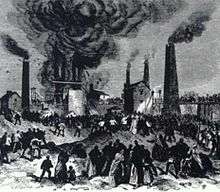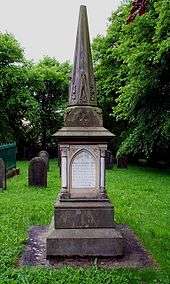Oaks explosion

The Oaks explosion occurred at the Oaks Colliery, near Stairfoot, Barnsley, West Riding of Yorkshire on 12 December 1866 killing 383 miners and rescuers. The disaster happened after a series of explosions caused by flammable gases ripped through the workings. It remains the worst colliery or mining disaster in England, and the second worst mining accident in the United Kingdom, after the Welsh Senghenydd Colliery Disaster.[1]
Background
The Oaks Colliery, which was one of the largest coal mines working the Barnsley area in South Yorkshire Coalfield, mined a seam that was notorious for firedamp. Almost 20 years before, on 5 March 1847, the Oaks Colliery suffered its first disaster when a blast killed 73 men and boys. As mine management were aware of firedamp, there were strict rules about the use of safety lamps. A ventilation system was also used to carry any gas that emerged from the seam out of the mine. However the coal in this seam was known to contain methane making it a very dangerous working environment. If a naked flame touched methane gas it would cause an explosion.
Explosion
On Wednesday 12 December 1866, with less than an hour of the shift remaining, a huge explosion ripped through the workings. The force of the blast blew the cage up No. 1 shaft into the headgear, breaking the coupling. The cage was recovered and replaced to enable a party of "pit deputies" (foreman) to descend the pit to see the devastation. At the bottom of the shaft, they found a number of badly burned men who were sent up to the surface. The dead were taken to their homes and the survivors were given medical attention. By midnight, the exhausted rescuers withdrew to continue their work the next day.
The next morning, over 100 rescuers went down the pit in shifts with Mr Minto, the underviewer, and mining engineer Parkin Jeffcock to inspect the conditions under which they were working. But as Jeffcock finished inspecting the upcast shaft, another huge explosion occurred killing 27 of the rescuers. The blast was powerful enough to rush up all three shafts at the colliery. A third explosion took place a few hours later, again affecting all three shafts.
It was thought that the explosions killed 361 men and boys, based on an estimate of 340 working below ground in the first explosion (with six survivors) and 27 rescuers being killed on 13 December. A 2016 volunteer research project by the Dearne Valley Landscape Partnership has produced a list of 383 individual names.[2] The ages of those killed ranges from 10 to 67.
Cause
A thorough investigation into the disaster could not conclusively ascertain what had caused the explosion or what was the source of the first ignition. But some survivors mentioned an exceptionally violent blast just before the main explosion. This may have been caused by the driving of a drift near the main seam, meaning the digging of a new workings may have ignited pockets of firedamp. An initial blast may have caused a chain reaction triggering the firedamp and coal dust explosion that devastated the rest of the pit.
Although the cause was never properly discovered, a further 17 explosions would be recorded in the Oaks Colliery's history until it closed.
Legacy

A monument to all those killed in the disaster was erected at Christ Church, Ardsley, Barnsley, in 1879. A second monument was erected in 1913 to Parkin Jeffcock and the volunteer rescuers who were killed.[3][4]
The accident remained the worst in British mining history until the Senghenydd Colliery Disaster, in the South Wales coalfield in 1913, which claimed 439 lives. The Oaks disaster remains the worst in an English coalfield.
See also
Coordinates: 53°33′10.35″N 1°27′5.08″W / 53.5528750°N 1.4514111°W
References
- ↑ "Major mining disasters in Britain". BBC. 18 September 2011.
- ↑ "Oaks Disaster Victims". Dearne Valley Landscapes Partnership.
- ↑ "Oaks Colliery Disaster Rescuers' Memorial". Public Art Research Archive. Retrieved 9 March 2008.
- ↑ "Oaks Colliery Disaster Rescuers' Memorial Barnsley Yorkshire 2". Flickr.
- Duckham, Helen; Duckham, Baron (1973). Great Pit Disasters: Great Britain 1700 to the present day. Newton Abbot: David & Charles. ISBN 0715357174.
- Local Archives – Barnsley Public Library
